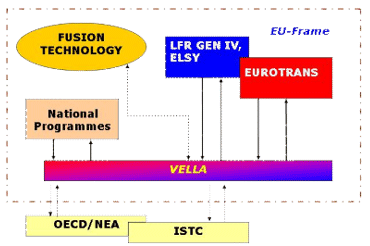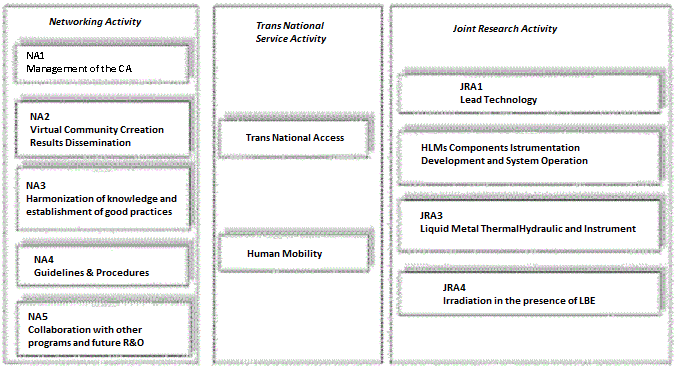PROJECT SUMMARY
VELLA (Virtual European Lead Laboratory) is an Euratom FP6 project which emerged from the idea to create a common research area among the European Union (EU) and its associate countries (such as Switezland) in the field of lead technologies.Owing to its attractive properties, a wide use of pure lead, as well as its alloys (such as lead-bismuth, lead-lithium), is foreseen in several nuclear-related fields: it is studied as coolant for critical and sub-critical nuclear reactors, as spallation target for neutron generation and for tritium generation in fusion systems.
Given this possible future extensive use of lead in nuclear systems, a deep understanding of its physical properties and engineering applications is absolutely needed. As a consequence, given the quite limited nowadays experience , large efforts both at national level as well as within the EU are dedicated to the heavy liquid metal technologies.
In particular, the EU has launched several large R&D programmes, that are strongly interconnected, such as EUROTRANS-DEMETRA (EUROpean research programme for the TRANSmutation of high level nuclear waste in Accelerator Driven Systems-DEvelopment and assessment of structural materials and heavy liquid MEtal technologies for TRAnsmutation systems), ELSY (European Lead-Cooled System) and, of course VELLA. All these projects are aiming to integrate the major existing European infrastructures, developing synergies and complementarities among the laboratories hosting the facilities and the research groups.
As already hinted, the driving idea of VELLA is to homogenize the European research area in the field of lead technologies for nuclear applications in order to produce a common platform of work which continues also after the end of the initiative.
In this context, VELLA has the ambitious intent to create a network composed of all the major laboratories and a platform to strongly connect the different groups of experts, in order to develop a common definition of good operational practices and to promote the exchange of the scientific results by means of appropriate and innovative tools and procedures. Moreover, it has the significant objectives to encourage the access to the main existing facilities in the EU to different specialist groups, to sustain the technological development and the qualification activities, as well as to create a well-identified European “scientific community”, organized to support all the required technological challenges and the necessary research development.

Figure 1. The European research area in the field of HLM technologies
In this framework, detailing the abovementioned goals, VELLA is articulated in:
The scope of the NA is to create a virtual community of researchers, to
define common standards and protocols for the use of the facilities, to
interact with the programmes and the institutions operating in this field.
The objectives of the TA are to promote the access of researchers, universities
and firms to the existing infrastructures and knowledge, in order to increase
the competitiveness of the European industry, to train the researchers in
using the EU infrastructures during the three years duration of the project
and to help the human mobility between and towards the laboratories. The
JRA have the goals to create a base of knowledge on lead technologies, develop
and operate Heavy Liquid Metal (HLM) components and instrumentations, study
the HLM thermal hydraulics.

Figure 2. VELLA activities structure
PROJECT OBJECTIVES
Exploiting the favourable characteristics of the Integrated Infrastructure Initiatives, a tool which combines, within a single contract, several activities essential to reinforce research infrastructures and to provide an integrated service at the European level, VELLA, in detail, has the major objectives to:
In particular, it has to be underlined that the last objective, the scientific staff mobility, is one of the key goals of the project. This objective, with all the others listed above, is planned to be achieved in a more efficient way enhancing closer and broader-base collaborations among the participating partners and defining a coherent operational programme among the existing Infrastructures on the basis of their specific capabilities and resources.
As already stated, given the possible future extensive use of HLM in nuclear systems, a deep understanding of its physical properties and engineering applications is absolutely needed. For this reason, a strong common effort in several aspects is required:
VELLA, acting in a concerted way with the other FP6 programmes, more dedicated to cover the scientific and technological aspects, exploits the integration of the existing infrastructure, develops synergies and complementarities among laboratories and research groups, promotes standards and protocols and trains the new generation of engineers and scientists to create experts in HLM technologies for nuclear applications.
Regarding the exchange of know-how, VELLA, in a cross-disciplinary fertilisation process, has the ambitious targets of:
In this sense, the ultimate goal of this initiative is to create a unique “Virtual” European Laboratory with coherent experimental standards and complementary capabilities, able to promote original technological developments. VELLA wishes to promote a continuous exchange of information and knowledge across Europe, in order to create a general frame for the harmonization of the present and future actions and perspectives in this field.
It is also expected that VELLA will have a long term structuring effect on the EU research area in the field of HLM technologies for nuclear applications: the “outcome” of VELLA, in fact, in integrating facilities and research groups, is assumed to go well beyond the scheduled duration of the Initiative and the positive effects on the homogenisation of the European HLM laboratories are supposed to be a durable asset.
It is expected that the VELLA could become an important reference action also in an international frame.
Exploiting the favourable characteristics of the Integrated Infrastructure Initiatives, a tool which combines, within a single contract, several activities essential to reinforce research infrastructures and to provide an integrated service at the European level, VELLA, in detail, has the major objectives to:
- create an “authentic” community of researcher in the spirit of ERA
- maximise the value of the existing facilities stimulating and easing the access of the research institutions and enterprises to all the larger laboratories
- promote protocols, standards and a consistent methodology for measurement techniques, experimentation, data collection and data analyses
- guarantee a coherent circulation and practical application of knowledge
- improve the exchange of the long term technological research on HLM
- train a new generation of nuclear engineers and scientists, in the existing laboratories, in order to create experts in HLM technology
- exchange members of the staff among the participating partners
In particular, it has to be underlined that the last objective, the scientific staff mobility, is one of the key goals of the project. This objective, with all the others listed above, is planned to be achieved in a more efficient way enhancing closer and broader-base collaborations among the participating partners and defining a coherent operational programme among the existing Infrastructures on the basis of their specific capabilities and resources.
As already stated, given the possible future extensive use of HLM in nuclear systems, a deep understanding of its physical properties and engineering applications is absolutely needed. For this reason, a strong common effort in several aspects is required:
- Scientific, in order to cover the lack of knowledge and experience presently existing in this field (thermo physical properties, corrosion properties, etc.)
- Technological, in order to develop and validate the needed technologies and accumulate know-how for a safe and reliable use of HLM as a coolant in sub-critical and critical nuclear reactors, as a spallation target in ADS and advanced neutron sources, or as a component of the blanket of fusion reactors
- Regulatory, in order to provide the necessary enhancement of the existing safety rules to allow the licensing of those facilities
- Formative, in order to create skilled personnel capable of handling this technology
VELLA, acting in a concerted way with the other FP6 programmes, more dedicated to cover the scientific and technological aspects, exploits the integration of the existing infrastructure, develops synergies and complementarities among laboratories and research groups, promotes standards and protocols and trains the new generation of engineers and scientists to create experts in HLM technologies for nuclear applications.
Regarding the exchange of know-how, VELLA, in a cross-disciplinary fertilisation process, has the ambitious targets of:
- networking different groups of specialists and their laboratories, both for the consistent definition of operation and for the exchange of scientific results by means of appropriate and innovative tools and procedures
- allowing the access to the existing facilities (especially the largest KALLA in FZK and LATM in Brasimone) to the different specialist groups and industrial enterprises, enhancing also the human mobility
- supporting medium term and special technological development and qualification activities
- creating a European homogenous “scientific community” ready to support the technological challenges and research requirements in the field of nuclear application in HLM
In this sense, the ultimate goal of this initiative is to create a unique “Virtual” European Laboratory with coherent experimental standards and complementary capabilities, able to promote original technological developments. VELLA wishes to promote a continuous exchange of information and knowledge across Europe, in order to create a general frame for the harmonization of the present and future actions and perspectives in this field.
It is also expected that VELLA will have a long term structuring effect on the EU research area in the field of HLM technologies for nuclear applications: the “outcome” of VELLA, in fact, in integrating facilities and research groups, is assumed to go well beyond the scheduled duration of the Initiative and the positive effects on the homogenisation of the European HLM laboratories are supposed to be a durable asset.
It is expected that the VELLA could become an important reference action also in an international frame.
